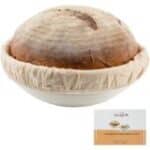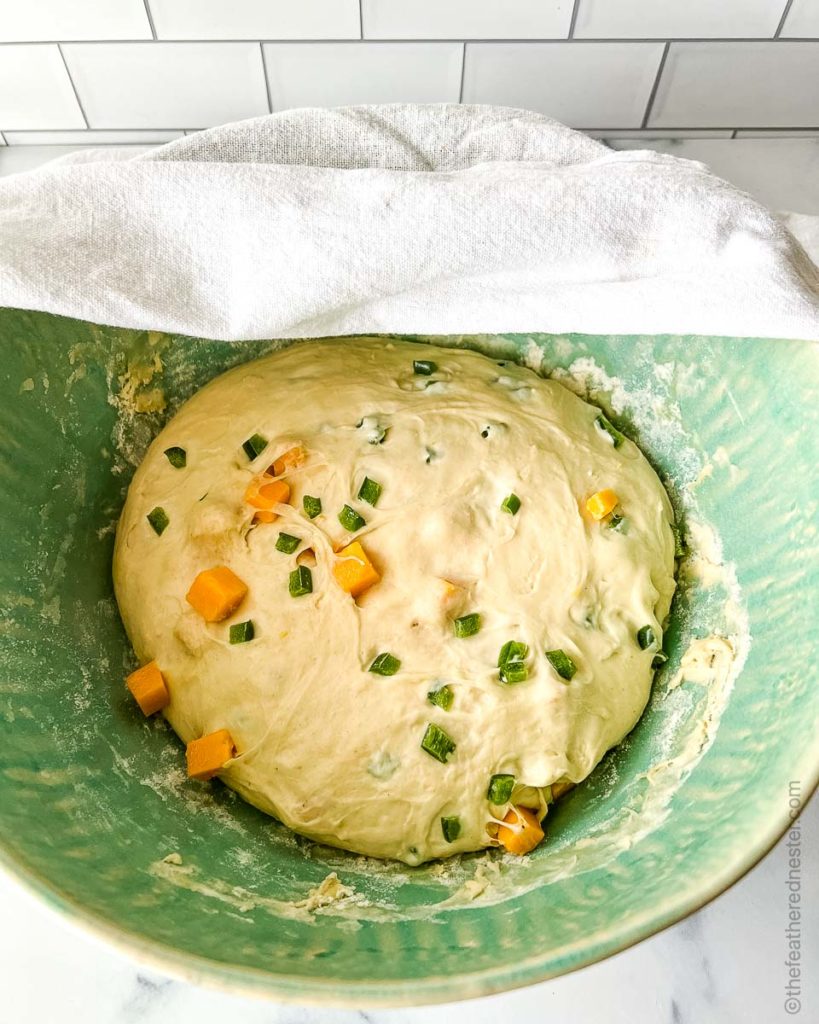This Jalapeno Cheddar Sourdough Bread is perfect for you whether you are a seasoned baker or a beginner. This nearly foolproof recipe bakes up the most terrifically tangy sourdough bread with tasty, melty cheddar cheese and mildly spicy jalapenos. Or go for a walk on the milder side and skip the peppers.

Content Covered Here
Jalapeno Cheddar Sourdough Bread
Sourdough recipes are tried-and-true classics that continue to gain popularity with both new and longtime bakers. From sandwich bread to pizza crust and even cakes, it can do so much! With no yeast needed!
This cheesy jalapeno sourdough recipe is a fun way to try something new. It’s a beginner-level bread recipe, just like this Irish Soda Bread.
The tanginess is perfect to combine with gooey cheese and spicy peppers. And the wonderfully easy overnight prep method makes this a practically no-fail recipe. So you know you’re going to be baking up delightful loaves every time.

If not everyone is a fan of peppers, you absolutely can leave them out and make a super cheesy version that has lots of flavors and no spiciness.
Any way you bake it, this dish is great to serve as a tasty centerpiece for fun and festive gatherings.
Or keep it on the countertop as a grab-a-hunk-and-go treat for everyone in the house to enjoy as a quick snack!
Ingredients

You only need a handful of ingredients and a bit of patience to make this recipe.
- An active bubbly sourdough starter is essential, of course. Be sure that your homemade sourdough starter has been fed recently so it’s ready to use!
- Warm filtered water – too hot or cold will prevent it from rising properly
- Bread flour – We like to use King Arthur Bread Flour
- Sea salt – just a pinch
- Jalapeno peppers – membranes and seeds removed, minced
- Cheddar cheese – shredded, or use 1/4-inch cubes
Our Favorite Tools To Make This Recipe
 Buy Now →
Buy Now →  Buy Now →
Buy Now → Recipe Notes and Tips
In a large bowl, add the starter. Mix in warm, filtered water, stirring until dissolved.
Then add the flour and salt, stirring with a dough whisk or wooden spoon until a thick, shaggy dough forms.
Cover it with a clean, damp kitchen towel and let the dough rest for 30 minutes.
Lightly flour your countertop or surface then coax the dough from the bowl.
Add the minced jalapeno and cheddar cheese on top of the dough then knead for a minute until mixed in.

Cover the dough bowl with a damp towel (or plastic wrap), and let it rise in a warm space (70º-85ºF) for at least 6-8 hours. We usually let the dough ferment overnight. Do not refrigerate the dough.
Check your dough to see that it is bubbly and has increased or doubled in size. Lightly flour your countertop and pull the dough from the bowl.
Shape the dough by a set of stretches and folding: pull an edge of the dough 5″ and tuck it into the middle of the dough, then rotate the dough 1/4 of a turn and stretch and fold again.
Let it rest for 10 minutes.

Line a medium bowl with a floured towel, or use a banneton bowl with a linen cover and dust heavily with flour. Let dough rise in it for 30 – 60 minutes.
Preheat your oven to 450º (without the Dutch oven pot). Cover the dough bowl with a long piece of parchment paper, and turn it over onto the countertop.

Slash the top of the loaf with a lame or sharp serrated knife. Gently lower the parchment paper dough into a heavy pot with a tight-fitting lid. Do not preheat the pot.

Place the covered pot in the oven and bake, covered for 30 minutes. Remove the lid and bake for 20 minutes.
Then bake it directly on the oven rack for 10 minutes to crisp the exterior.
Let cool for an hour before slicing and serving.

Frequently Asked Questions
Yes, simply substitute bread flour 1:1 with all-purpose flour. This substitution may result in a smaller loaf.
Yes, it freezes well. Freezing over refrigerating will keep the crust softer. Place in an airtight zipper bag and keep in the freezer for up to 3 months. Let it thaw at room temperature, then slice and enjoy.
The crust will be light golden brown, and it’ll sound hollow when you give the loaf a gentle tap. If you’d like to test the internal temperature, it should be 195°-200°F.
If you tried this jalapeno cheddar sourdough recipe or any other recipe on my website, please leave a 🌟 star rating and let me know how it went in the 📝 comments below. Thanks for visiting!

Jalapeno Cheddar Sourdough
Equipment
- heavy pot with a lid, like a dutch oven cast iron pot or stockpot - (4 or 5 quart pot)
Ingredients
- ¼ cup (60 grams) sourdough starter, unfed or discard
- 1½ cups (350 grams) warm filtered water (95º to 100º F)
- 4 ¼ cups (500 grams) bread flour
- 1 ½ teaspoon (9 grams) sea salt
- 2 jalapeno peppers, membranes and seeds removed, minced
- 1 cup (4 ounces or 100 grams) cheddar cheese, shredded or 1/4" cubes
Instructions
- In a large bowl, add the sourdough starter. Mix in warm, filtered water, stirring until dissolved. Add bread flour and salt. Stir with a dough whisk or wooden spoon until a thick, shaggy dough forms. Wet your hands, and finish mixing dough by hand. Cover the sourdough with a clean, damp kitchen towel and let the dough rest for 30 minutes.
- Lightly flour your countertop or surface then coax the dough from the bowl. Add minced jalapeno and cheddar cheese to the top of the dough, then knead them in for about 1 minute. The fillings should be evenly distributed in the dough. Return the sourdough to the bowl, cover with a damp towel, and let rise in a warm space (70º-85ºF) for 8-10 hours. Overnight on the countertop or in the oven (turned off) is a good place. Do not refrigerate the dough.
- After fermentation or bulk rise, lightly flour your countertop and shape the dough by stretching and folding: pull an edge of the dough 5" and tuck it into the middle of the dough, then rotate the dough 1/4 of a turn and stretch and fold again. Let the dough rest for 10 minutes.
- Line a medium bowl with a floured towel, or use a banneton bowl with a linen cover and dust heavily with flour. Let dough rise in it for 30 – 60 minutes.
- Preheat your oven to 450º (without the Dutch oven pot). Cover the dough bowl with a long piece of parchment paper, and turn it over onto the countertop. Slash the top of the loaf with a lame or sharp serrated knife. Gently lower the parchment paper dough into a heavy pot with a tight-fitting lid. Do not preheat the pot.
- Place the covered pot into the oven and bake covered for 30 minutes. Remove the lid from the pot and bake for 20 minutes. Using oven mitts, carefully remove the bread from the pot and bake it directly on the oven rack for 5-10 minutes to crisp the exterior. Let cool at least 1 hour before slicing and serving.


Stacy Litwin says
How much are we supposed to be having the dough rise? Like 50% or to double in size? Just wondering because I know things rise really slow at my house so wondering what the end goal is
Renae says
The level of activity after the bulk rise is most important. The dough should have risen at least 50% and shows bubbles on top and bottom. If your house is cooler, I recommend using clear bowls for the long-rise so you can see the activity level underneath. Typically, I see more bubbles underneath than on top.
Stephanie says
I’ve been eyeing up this bread for a while now. I’m working with a toaster oven so I was bummed when I couldn’t find a sandwich bread recipe for this. Figured I’d play around and see how it came out if I put it into a bread pan. It’s delicious!! I skip the second to last step and just let it rest/rise in the pan before baking. I brought my first loaf to work, it was a hit. Now I’m currently making a second loaf. And… THIS RECIPE IS EASY!
Renae says
I am so happy to heat this!
Heather says
I’m curious about not pre-heating the Dutch oven. I’ve always preheated, going to try as is because I hate when people comment on a recipe they didn’t follow. Have you tried it both ways? Thanks for the recipe, dough is bulk rising as I type:)
Renae says
No, I haven’t tried this recipe with a preheated Dutch oven. But, while recipe testing my original sourdough bread recipe (that this is based on) I did try it both ways and did not notice any difference in texture or rise. As a personal preference, though, I do not like trying to drop the unbaked sourdough dough into the preheated pot. I actually burned myself once doing that. It’s way easier for me to take it out after it’s baked (thanks to the parchment paper).
KC says
Does this recipe really call for discard, I would typically feed my starter in the AM and use it in the evening. I just want to make sure this really calls for unfed
Renae says
As long as it’s been at least 6 hours (preferably 12 hours) since you fed your starter, you will be fine. I have tested it with a starter fed around 6 hours prior, 12 hours, and a true discard. All of them came out nicely.
Arlis says
This looks delicious! I am wondering why, with this particular recipe, you say NOT to refrigerate the dough?
Renae says
Some sourdough bread recipes use a refrigerated bulk/fermentation rise. My sourdough bread recipes do not, they rise at room temperature. I get a lot of questions about that, as well as preheating the Dutch oven. My recipes do not use a preheated Dutch oven. Happy baking!